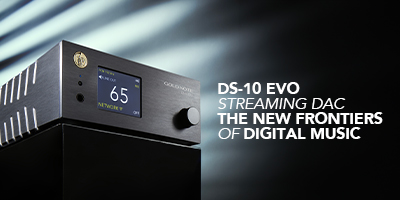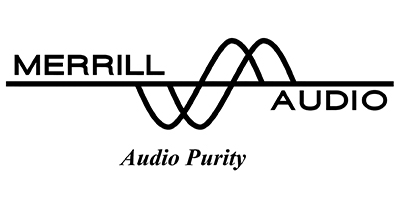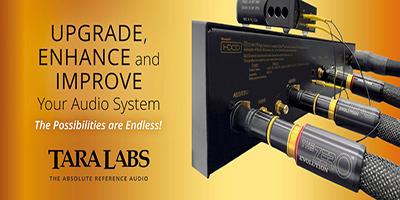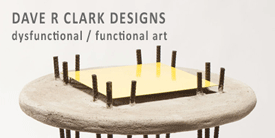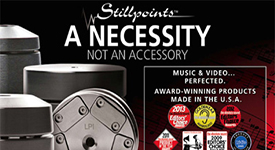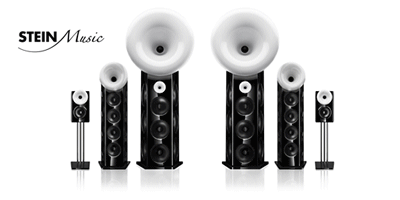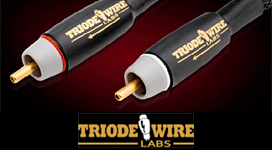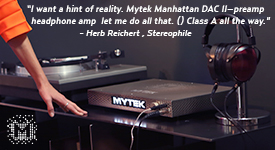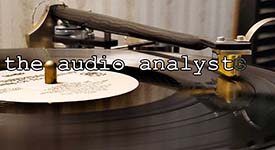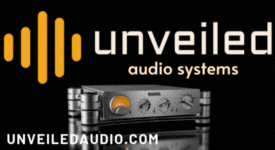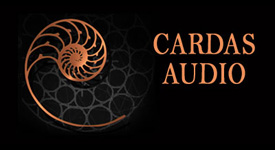♫ Audio Q & A
I thought I’d put together a little handy reference to the most common questions I get about the HiFi hobby, and answers that I think will be useful for guiding you to a happy place.
Q: What’s the most important aspect of HiFi?
A: Listening to recorded musical performances in your home is the cornerstone of HiFi, the very reason it exists. Your HiFi offers the chance to indulge in your favorite music and discover new musical treasures.
In addition to the sheer pleasure of listening to the recorded music you enjoy, listening to music also can offer many other benefits: it can lead to better learning, enhance memory, moderate mental illness, reduce anxiety, alleviate symptoms of depression, improve heart health, decrease fatigue, enhance exercise performance, and even help manage pain. What’s not to like? More HERE.
Q: How much do I need to spend to get a satisfying HiFi system?
A: A satisfying HiFi system that sounds great and plays music well can be put together for around $4K USD, or even less if you are comfortable with a soldering iron and building kits.
For example, I was very impressed with the Cabasse Rialto system I heard at the Pacific Audio Fest in 2023, which came in at approximately $4000 USD for loudspeakers, amplification, room correction, streaming ... everything except for the iPhone that was used as a Bluetooth streaming source.
Having said that, most of the audio systems I write about here at Jeff’s Place & Positive Feedback are high-performance enthusiast audio systems that have little regard for cost.
Typically, complete high-performance enthusiast audio systems have costs that are comparable to purchasing an automobile, where pricing can range anywhere from what would be a relatively affordable $20K commuter car / entry level high-performance audio system, to well over a million dollars for exotic enthusiast cars / audio systems.
Q: What should be my first criterion when choosing an audio system?
A: After deciding on your budget for an audio system, by far, the living space you want to install your audio system into is the biggest consideration.
One thing to keep in mind is that loudspeaker designs with non-adjustable crossovers are typically optimized to work well in one of two room placements. The first placement is positioning of loudspeakers into room corners (room boundary placement), and the second placement is positioning of loudspeakers farther out into a room (an audiophile-style placement).
Both loudspeaker positioning methods have strengths and weaknesses. As an audio hobbyist & journalist, I use both positioning methods in my home audio & audio-visual systems, depending on the room’s size and layout, and my goals for a particular system.
Loudspeaker designs with adjustable crossovers, or that feature DSP room correction in their design, can provide more flexibility in placement.
Basically, you will want to know which loudspeaker placement you want to use for your living space, as it can dictate which loudspeakers will work best for you in that space.
If you live in a smaller space like an apartment, condo, or a smaller home, it can be crucial to place your audio system into a room in a way that integrates with and maximizes your living space.
Typically, this involves positioning your audio equipment close to the front wall of a room, and placing your loudspeakers into the room’s corners (referred to as “room boundary positioning”).
Beyond maximizing living space, there are several advantages to room boundary positioning of loudspeakers. Firstly, it can reduce loudspeaker interactions with room nodes that compromise sound quality, so it’s essentially a “plug & play” positioning approach that makes optimum setup easy. Secondly, for monaural recordings, it tends to create a wider and more natural sounding soundstage, which can give monaural recordings a width that can match that of stereo recordings.
Is there a downside of room boundary positioning of loudspeakers compared to typical audiophile positioning of loudspeakers?
For most listeners the answer is “No.” However, room boundary positioning of loudspeakers can result in a shallower depth dimension to the soundstage, which may put off some audiophile listeners who primarily listen to stereo recordings and want to achieve maximum spaciousness and soundstage depth.
This leads us to a second approach to positioning loudspeakers, which I’ll casually call “audiophile positioning”.
For audiophile hobbyists with a dedicated listening room, and who value maximizing the visuospatial properties of stereo recordings, they often set their loudspeakers far out into the room - a third to a fifth of the room’s dimensions, for example - to give a sense of enhanced spaciousness and imaging for stereo recordings.
This “audiophile positioning” method is a bit trickier to get right. Where you place the loudspeakers in the room is critical, due to the existence of room nodes that can alter the balance across the seven frequency bands of the audio spectrum (usually the bass band), which can have a big affect on overall tonal balance.
Even after you have positioned your loudspeakers in the optimum position to minimize interactions with room nodes in your particular room, you may need still need room acoustic treatments to get the sound to integrate properly in your room, or some form of active equalization (e.g. an equalizer, or DSP room correction).
For those who want to go the audiophile positioning route with loudspeakers, I highly recommend Jim Smith’s Get Better Sound, which will provide lots of ideas for sorting out the sound of your audio system.
Is there a downside to the “audiophile” loudspeaker positioning route? The first and most obvious downside is that it can be difficult to achieve both maximized visuospatial performance and a well-balanced musical presentation. It’s not unusual for audiophiles to spend years, or even decades, trying to get performance fully optimized in their room.
Secondly, if you enjoy listening to a lot of historic monaural recordings, this positioning tends to compress them in the soundstage width dimension, which you may find disconcerting.
Thirdly, if you try to maximize visuospatial performance using the best recordings from the stereo magnetic era of recording, it tends to give a narrower band of musically pleasing performance for recordings outside that paradigm. Recordings similar to what you voiced the system with will sound good, but most other recordings tend not to sound so good.
A better approach is to use a comparison by contrast approach to voicing, using recordings of varying fidelity that span the recording eras, so that your audio system will be able to play a wider variety of music in an enjoyable fashion.
However, when you do get everything dialed in “just right” for your room and personal tastes, audio performance can be magical with the very best stereo recordings, as well as with recordings that span the low- to high-fidelity eras of the recording arts.
Q: Should I go with separates or integrated amplifiers?
A: A friend named Sebastian, who has since passed away, had a fondness for the KISS principle: “Keep It Simple, Sebastian,” he would often say.
Back in the early days of audio, integrated amplifiers tended to offer lower performance compared to the more enthusiast-oriented separate components.
This is no longer the case, however, as the best integrated amplification components offer performance that can equal or exceed that of most separates.
Generally speaking, the fewer variables (components) you are dealing with in an audio system, the easier it is to get it performing at its optimum.
I think keeping an audio system as simple as possible is the best way to go for most listeners, so high-performance integrated amplifiers tend to be my favorites, and are what I recommend for most enthusiasts.
Q: Which is better, vacuum tube or solid-state amplification?
A: You can get excellent performance from both vacuum tube and solid-state amplification.
Here’s a couple of things for you to consider in choosing amplification:
Heat: Both vacuum tube amplification and most solid-state amplification will heat up a room considerably, which is not a big deal if you have a high-performing HVAC system. However, if you live in a hot climate zone, you may find that cool running Class D amplification that doesn’t heat up a room - a newer type of solid-state amplification - may be your friend. If you live in a cooler climate zone, these hot running amplifiers can be your friend. In my A-V system I tend to alternate between hot-running vacuum tube or solid-state amplification in the colder months, and Class D amplification in the hotter months.
Maintenance: You have to maintain vacuum tube amplification by replacing vacuum tubes as they age, and with solid-state amplification no maintenance is required.
Vacuum tubes can be costly to replace depending on the type, and when trade wars are going on, most vacuum tubes are made in China and Russian, so they can become scarce and expensive. Tip: Prepare for scarcity by keeping a few sets of replacement vacuum tubes on hand.
Longevity: Vacuum tube components tend to have longer lifespans, and can be restored to like-new condition as needed. Solid-state amplification can have relatively long lifespans, but when they fail they may not be repairable. You can see this in the vintage HiFi scene. How many vintage solid-state amplifiers are desirable? Not many, and many tend to be throw aways after they fail. Vintage tube amplifiers are way more popular, as with a little internal restoration, and a fresh set of vacuum tubes, they can provide decades of musical enjoyment.
From a purely musical enjoyment standpoint, I hear better performance from vacuum tube amplification. For amplifiers in particular, single-ended-triode designs are my favorites. This is why you see solid-state designers trying to find amplification devices that mimic the performance of the best vacuum tubes. So far, the best solid-state devices can only asymptotically approach the performance of the best vacuum devices, and you can hear it in the playback of the music.
Q: What’s better, digital or analog playback?
A: If you are talking about the best playback of stereo magnetic era recordings in the highest fidelity, then master tapes played back on reel-to-reel machines are at the top of the heap. Then, depending on the audio engineer you are talking to, high-resolution digital transfers of said master tapes played back on the best digital equipment are a close second. Vinyl records made from those same master tapes would be next, with CDs of said master tapes next, and bringing up the rear would be low-resolution streaming.
So, for the best playback of stereo magnetic era recordings on the best equipment, the order of fidelity is: master tapes > high-resolution digital transfers > vinyl records > CDs > low-fi streaming.
All of these formats can provide very engaging presentations of the music with the right audio kit playing them back.
However, maybe that’s not the best way to look at it. Let’s say you are a listener that wants to listen to all the music from all the eras of recording (like me), and you want to keep things relatively simple. What’s the best choice for you?
Master tapes played over reel-to-reel sound great, but will not be practical for most listeners due to the expense involved, and due to the very limited selections of music available on tape, which are typically a handful of very best recordings from the stereo magnetic era that are popular with audiophiles. There’s not a lot to choose from. They have impressive fidelity, but from a practical perspective of listening to any music you feel like listening to, they come in at last place.
The best vinyl records are still amazing from a fidelity standpoint, and there is good availability of records, so for many listeners vinyl records will be a good choice. Still though, vinyl can be limiting, as recordings available on vinyl are typically only from the monaural & stereo eras of magnetic recording. There’s a few vinyl records that have transfers from the 78rpm records of the acoustic and electrical eras of the recording arts, but they are few and far between.
If you want to listen to a wide variety of music that spans the acoustic, electrical, monaural & stereo magnetic, and digital, eras of recording, at the moment CDs are the best choice. There’s lots of music from every recording era available on CD, so for the music lover who wants to listen to everything, CDs are the way to go.
But … streaming is gaining ground on CDs rapidly. There’s lots of music to listen to from every era of recording, and except for the premium streaming services, it is free to listen to the music. No expensive albums to buy. Streaming is sort of the new FM radio, with decent sound quality, and free access.
If you’re just getting started in audio, streaming might be the way to go. Friend and design genius, Yazaki-san, sent me an inexpensive Bluetooth DAC that he hot-rodded with a few circuit mods using extremely good components. The fidelity even when listening to low-resolution streams is remarkable.
Of course, you could have a source for each format, and just enjoy the diversity of the listening experiences.
Or you could pick a couple of formats that would give you the most enjoyment overall. That’s me at the moment, as I really enjoy listening to vinyl, CDs, and streaming.
Ok, that’s all for now, I’ll add more Q&A as time allows.
As always, thanks for stopping by!

